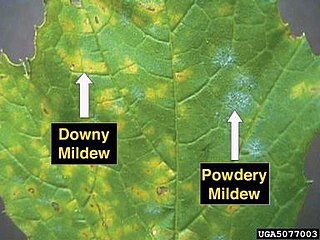
Powdery mildew is a fungal disease that affects a wide range of plants. Powdery mildew diseases are caused by many different species of ascomycete fungi in the order Erysiphales. Powdery mildew is one of the easier plant diseases to identify, as the signs of the causal pathogen are quite distinctive. Infected plants display white powdery spots on the leaves and stems. This mycelial layer may quickly spread to cover all of the leaves. The lower leaves are the most affected, but the mildew can appear on any above-ground part of the plant. As the disease progresses, the spots get larger and denser as large numbers of asexual spores are formed, and the mildew may spread up and down the length of the plant.

Uncinula necator is a fungus that causes powdery mildew of grape. It is a common pathogen of Vitis species, including the wine grape, Vitis vinifera. The fungus is believed to have originated in North America. European varieties of Vitis vinifera are more or less susceptible to this fungus. Uncinula necator infects all green tissue on the grapevine, including leaves and young berries. It can cause crop loss and poor wine quality if untreated. The sexual stage of this pathogen requires free moisture to release ascospores from its cleistothecia in the spring. However, free moisture is not needed for secondary spread via conidia; high atmospheric humidity is sufficient. Its anamorph is called Oidium tuckeri.
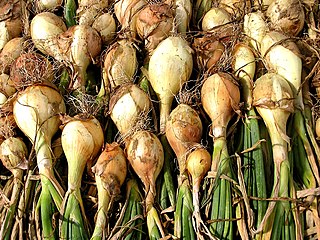
White onion or Allium cepa are a cultivar of dry onion which have a distinct light and mild flavour profile. Much like red onions, they have a high sugar and low sulphur content, and thus have a relatively short shelf life. White onions are used in a variety of dishes, such as those of Mexican and European origin. Their uses in dishes often relate to their mild nature, they are often included in dishes to provide a light, fresh and sour taste to dishes and are often added uncooked to dishes such as salads.

Hyaloperonospora parasitica is an oomycete from the family Peronosporaceae. It has been considered for a long time to cause downy mildew of a variety of species within the Brassicaceae, on which the disease can cause economically important damage by killing seedlings or affecting the quality of produce intended for freezing. Hyaloperonospora parasitica causes downy mildew on a wide range of many different plants. It belongs to the Kingdom Chromista, the phylum Oomycota, and the family Peronosporaceae. The former name for H. parasitica was Peronospora parasitica until it was reclassified and put in the genus Hyaloperonospora. It is an especially vicious disease on crops of the family Brassicaceae. It is most famous for being a model pathogen of Arabidopsis thaliana which is a model organism used for experimental purposes. Accordingly, the former Hyaloperonospora parasitica has been split into a large number of species. For instance, the taxonomically correct name of the parasite of the well-known model organism Arabidopsis thaliana is Hyaloperonospora arabidopsidis, not H. parasitica, whereas the pathogen of Brassica has to be called Hyaloperonospora brassicae.
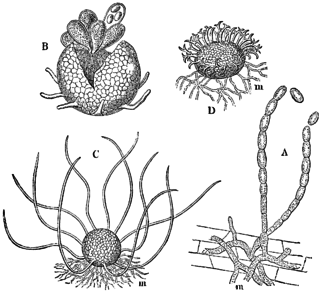
Erysiphe cruciferarum is a plant pathogen of the family Erysiphaceae, which causes the main powdery mildew of crucifers, including on Brassica crops, such as cauliflower, cabbage, broccoli, and Brussels sprouts. E. cruciferarum is distributed worldwide, and is of particular concentration in continental Europe and the Indian subcontinent. E. cruciferarum is an ascomycete fungus that has both sexual and asexual stages. It is also an obligate parasite that appears to have host specificity; for example, isolates from turnip will not infect Brussels sprout, and vice versa. While being a part of the family Erysiphaceae, it belongs to those members in which the conidia are formed singly and whose haustoria are multilobed.

Podosphaera macularis is a plant pathogen infecting several hosts including chamomile, caneberrie, strawberries, hop, hemp and Cineraria. It causes powdery mildew of hops.

Podosphaera pannosa is a plant pathogen. It produces a powdery mildew on members of the rose family.

Stemphylium solani is a plant pathogen fungus in the phylum Ascomycota. It is the causal pathogen for grey leaf spot in tomatoes and leaf blight in alliums and cotton, though a wide range of additional species can serve as hosts. Symptoms include white spots on leaves and stems that progress to sunken red or purple lesions and finally leaf necrosis. S. solani reproduces and spreads through the formation of conidia on conidiophores. The teleomorph name of Stemphyllium is Pleospora though there are no naturally known occurrences of sexual reproduction. Resistant varieties of tomato and cotton are common, though the pathogen remains an important disease in Chinese garlic cultivation.
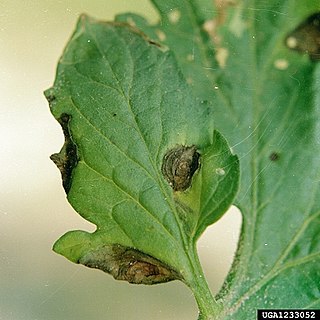
Alternaria solani is a fungal pathogen that produces a disease in tomato and potato plants called early blight. The pathogen produces distinctive "bullseye" patterned leaf spots and can also cause stem lesions and fruit rot on tomato and tuber blight on potato. Despite the name "early," foliar symptoms usually occur on older leaves. If uncontrolled, early blight can cause significant yield reductions. Primary methods of controlling this disease include preventing long periods of wetness on leaf surfaces and applying fungicides. Early blight can also be caused by Alternaria tomatophila, which is more virulent on stems and leaves of tomato plants than Alternaria solani.

Oidium mangiferae is a plant pathogen that infects mango trees causing powdery mildew. Powdery mildew of mango is an Ascomycete pathogen of the Erysiphales family that was initially described by Berthet in 1914, using samples collected from Brazil. O. mangiferae is found in all areas where mangoes have been raised long term, but is particularly widespread in India where both the host and the pathogen are native. Currently no teleomorph stage has been identified, but due to certain morphological characteristics it has been suggested that O. mangiferae belongs in the Erysiphe polygony group. Mango is the only known host for this pathogen, though O. mangiferae appears to be identical to fungi responsible for powdery mildew diseases on various other plant species, particularly oak, though some differences may be observed. In particular, the number of cells in conidiophores varies from 2 on mango to 3-5 on oak. O. mangiferae has been known to infect oak leaves in the laboratory, however due to the lack of a known teleomorph stage O. mangiferae is still considered to only be a pathogen of mango. Recent analysis of its ribosomal DNA suggests it is conspecific with Erysiphe alphitoides, the causative agent of powdery mildew in European oaks.
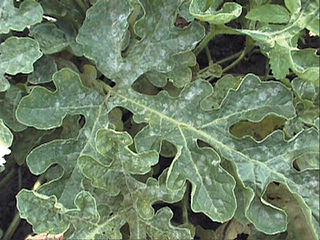
Podosphaera fuliginea is a plant pathogen that causes powdery mildew on cucurbits. Podosphaera fuliginea and Erysiphe cichoracearum are the two most commonly recorded fungi causing cucurbit powdery mildew. In the past, Erysiphe cichoracearum was considered to be the primary causal organism throughout most of the world. Today, Podosphaera fuliginea is more commonly reported.

Didymella bryoniae, syn. Mycosphaerella melonis, is an ascomycete fungal plant pathogen that causes gummy stem blight on the family Cucurbitaceae, which includes cantaloupe, cucumber, muskmelon and watermelon plants. The anamorph/asexual stage for this fungus is called Phoma cucurbitacearum. When this pathogen infects the fruit of cucurbits it is called black rot.

Pseudoperonospora cubensis is a species of water mould known for causing downy mildew on cucurbits such as cantaloupe, cucumber, pumpkin, squash and watermelon. This water mould is an important pathogen of all these crops, especially in areas with high humidity and rainfall, such as the eastern United States. In most years the disease is an annual, late-season problem on squash and pumpkin in the eastern and central United States, however, since 2004 it has become one of the most important diseases in cucumber production. Considered a highly destructive foliar disease of cucurbits, successful breeding in the mid-twentieth century provided adequate control of downy mildew in cucumber without the use of fungicides. The resurgence in virulence has caused growers great concern and substantial economic losses, while downy mildew in other cucurbit crops continues to be a yearly hindrance.
This article summarizes different crops, what common fungal problems they have, and how fungicide should be used in order to mitigate damage and crop loss. This page also covers how specific fungal infections affect crops present in the United States.

Peronospora destructor is a plant pathogen. It causes downy mildew on leaves of cultivated and wild Allium. Allium cepa is most often affected, while Allium schoenoprasum (chives) and Allium porrum (leek) are only occasionally affected.

Ampelomyces quisqualis is an anamorphic fungus that is a hyperparasite of powdery mildews. This parasitism reduces growth and may eventually kill the mildew. These mycoparasites can live up to 21 days on mildew-free host plant surfaces, attacking powdery mildew structures as soon as they appear. A. quisqualis is used as the active ingredient in a commercial fungicide.
Stromatinia cepivora is a fungus in the division Ascomycota. It is the teleomorph of Sclerotium cepivorum, the cause of white rot in onions, garlic, and leeks. The infective sclerotia remain viable in the soil for many years and are stimulated to germinate by the presence of a susceptible crop.
Gummy stem blight is a cucurbit-rot disease caused by the fungal plant pathogen Didymella bryoniae. Gummy stem blight can affect a host at any stage of growth in its development and affects all parts of the host including leaves, stems and fruits. Symptoms generally consist of circular dark tan lesions that blight the leaf, water soaked leaves, stem cankers, and gummy brown ooze that exudes from cankers, giving it the name gummy stem blight. Gummy stem blight reduces yields of edible cucurbits by devastating the vines and leaves and rotting the fruits. There are various methods to control gummy stem blight, including use of treated seed, crop rotation, using preventative fungicides, eradication of diseased material, and deep plowing previous debris.

Botrytis squamosa is a fungus that causes leaf blight on onion that is distinctly characterized by the two stages – leaf spotting followed by blighting. The pathogen is an ascomycete that belongs to the family Sclerotiniaceae in the order Helotiales. The lesions start out as whitish streaks and take on a yellow tinge as they mature. They cause yield losses up to 30%. This fungus is endemic to the USA and has also been reported in Europe, Asia, and Australia. Typical management of this disease includes chemical fungicides with significant efforts being made to establish a means of biological control.
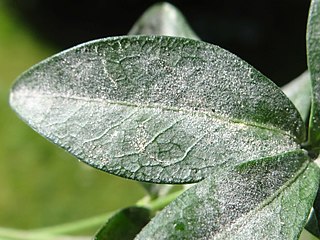
Golovinomyces orontii is a species of fungus that causes powdery mildew disease and it is in the family Erysiphaceae. It is an obligate biotroph that infects plants in several families including Acanthaceae, Asteraceae, Brassicaceae, Cucurbitaceae, and Lamiaceae.

















